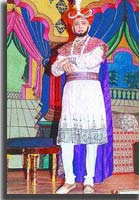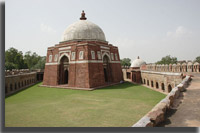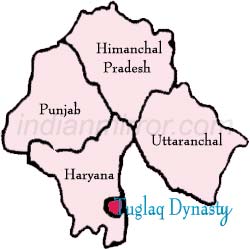History :
Tughlaq Dynasty was basically of Turkish origin and the family religion was Muslim. In the year 1321, Ghazi Tughlaq succeeded the throne and was given the title as Ghiyath al-Din Tughlaq. The Tughlaqs were able to withhold their rule for quite some time as they had strong allies like the Turks, Afghans and the Muslim warriors of south Asia. Ghiyath al-Din Tughluq was the one who founded the Tughlaq dynasty in India.The founders' real name was Ghazi Malik and he ruled from 1320 - 1325. He founded the city of Tughlaqabad outside Delhi. He fought battle against Khusrao Khan, who killed the last Khilji ruler. He made successful defense against the Mongols which made him an able ruler and the founder of a dynasty in India. He conquered areas including eastern portion of Bengal, a huge territory.

Administration
Mohammed bin Tughlaq had the idea of introducing token currency for the first time in India. He planned an expedition for the conquest of Khurasan and Iraq. But the scheme was abandoned as conditions in Iraq improved. The plan for the conquest of Karajal (Kumaon hills) also met with unsuccessful ending. During his last days, the whole of India became independent and three major independent states - The Empire of Vijaynagar, The Bahmani kingdom and Sultanate of Madura were founded. Dewan-i-Kohi a new department for agriculture was setup. He knew Arabic and Persian languages. He was an expert in philosophy, astronomy, logic, mathematics and was also a good calligrapher. He built the fortress of Adilabad and the city of Jahanpanah. The famous traveller, Ibn Batuta came to Delhi during 1334. He acted as the Quazi of the capital for 8 years. He has recorded the contemporary Indian scene in his 'Safarnamah'. (Called Rehla).


Place |
Delhi |
Period |
1320 AD- 1412 AD |
Language |
Urdu |
Religion |
Sunni Islam |
Rulers |
Ghiyas ud din Tughluq Shah I, Muhammad Shah II , Mahmud Ibn Muhammad , Firuz Shah Tughluq, Ghiyas ud din Tughluq II , Abu Baker, Nasiruddin Muhammad Shah III , Sikander Shah I |
Feroz Tughlak had not contributed much to expansion of the the territories in the empire, which he inherited. In 1360 he invaded Jajnagar to destroy the Jagannath Puri temple. In 1326 AD he met with success in his expedition to Sindh, before this he had led an invasion to Nagarkot with an idea to destroy the Jwalamukhi temples. The Sultan was not tolerant towards people with different religions. Feroz Tughluq also introduced reforms in the field of irrigation and also constructed buildings with architectural skill. He reformed the currency system. After him the dynasty began to disintegrate. The last Tughluq ruler Mahmud Nasir-uddin ruled from 1395-1413 AD. The invasion of Mongol ruler Timur in1398 A.D. sealed the fate of the Tughluq dynasty.


